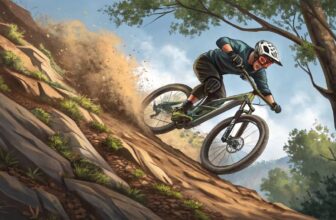Understanding Mountain Bike Bearings
Bearings play a key role in making your mountain bike roll like a dream. They’re little round wonders that keep everything from wheels to headsets moving smoothly. Get to know them, and your biking experience will kick into high gear.
Importance of Wheel Bearings
Wheel bearings are the unsung heroes in a mountain bike’s performance. They let the wheels spin like butter, cutting down on friction, so you zoom ahead with control. But hey, they don’t last forever. It’s smart to give them a look-see about once a year, cranking up the check-ups if you’re splashing through mud and rain.
Ignoring worn-out bearings? Not fun. Your ride starts feeling rough, you hear weird clicks, and everything just seems loosey-goosey. Then you’re looking at big-time wear and tear or even busted parts. If you’re hearing all those grim sounds, maybe it’s time for a pro visit.
Types of Bearings
Mountain bikes come fitted with two main types of bearings: open and sealed. Each type offers its perks depending on how you roll and how much you love fiddling with your bike parts.
1. Open Bearings:
- Typically show up in parts like non-sealed hubs and headsets.
- Need a regular good cleaning and check-up.
- Love to collect goop like dirt and water, which can wear them down.
- Find cracks or rust? Time to swap those out.
- Best for riders who enjoy a little hands-on maintenance action.
2. Sealed Bearings:
- Your go-to in fancy hubs, bottom brackets, and pivots.
- Come wrapped in a snug jacket, lasting longer and needing way less fuss.
- Not the fix-it kind. You just swap them out when they start acting up.
- Grinding or funky noises? That’s a sealed bearing telling you to let it go (Bicycles Stack Exchange).
For a quick comparison, peep at this table:
| Feature | Open Bearings | Sealed Bearings |
|---|---|---|
| Maintenance | Needs constant love and care | Little pampering needed |
| Durability | Less dirt resistant | Built like a tank with a strong casing |
| Common Issues | Wear and tear, rust | Grinding, weird ticking noises |
| Serviceability | DIY-friendly | Swap it out when it quits |
| Usage | Most hubs and headsets | High-end hubs, bottom brackets, pivots |
Getting a grip on these bearings and what they need will make a huge difference in your biking life. Curious for more? Check out other bits on mountain bike maintenance and dive into all the juicy details our other guides have to offer.
Signs of Wear and Maintenance
Checking Bearing Condition
Checking out your bike’s bearings once a year? Yeah, that’s wise. But if you enjoy splashy rides in the rain or tackle gnarly trails with mud and sand, expect to roll up your sleeves a bit more often. You can use something called a mechanic’s stethoscope (it’s like a doctor for bikes) to listen for any grinding, ticking, or other funky noises. Hear a click or feel some friction while twirling those handlebars? Could be your bike hinting it’s time for new bearings.
Here’s how you can snoop around like a pro:
- Lift the bike: Hoist it up on a stand so the wheels can spin freely.
- Listen and feel: Give those wheels and handlebars a spin, keeping your ears peeled for weird sounds.
- Visual inspection: Peek at the bearing seals and housing for any obvious wear or cracks.
Maintaining Open Bearings
Open bearings are kind of like party crashers, letting dirt and moisture in if unchecked. They need regular pampering. We’re talking clean, grease, and tweak time.
Steps for Maintaining Open Bearings:
- Remove and clean: Yank out those bearings, and scrub ’em with a degreaser to oust the grime and old grease.
- Inspect: Scout for any dented or worn ball bearings and races.
- Lubricate: Slather on some high-quality grease to the cleaned bearings, like butter on toast.
- Reassemble and adjust: Make sure the cone gently nudges the balls, but not so tight they can’t move. Crank that nut down snugly to keep everything in place.
Inspecting Sealed Bearings
Sealed bearings usually chill in the fancier parts of your bike and don’t need as much attention. Yet, if you hear grinding, clicking, or notice a wobbly sensation, they might need a fix-up. These aren’t fix-it-yourself items—they’ll need replacing.
Steps for Inspecting Sealed Bearings:
- Check for noise and rotation: Slowly spin the wheel or crank to listen for noises like they’re chewing on gravel.
- Feel for resistance: Twist your handlebars or wheel. Does it feel bumpy or uneven?
- Test for play: Wiggle the wheel or crank to check if your bike’s got the jitters.
| Bearing Type | Maintenance Frequency | Common Issues | Symptoms | Action |
|---|---|---|---|---|
| Open | Regular, 2-3 months | Dirt ingress, lack of lubrication | Noise, resistance, wear | Clean, lubricate, adjust |
| Sealed | Yearly or as needed | Grinding, ticking, clicking, loose feel | Grinding noise, notched rotation | Replace |
Keeping your mountain bike’s bearings in check is a clutch for smooth rides and fewer headaches. Hungry for more bike wisdom? Dive into our other articles on mountain bike maintenance and diy mountain bike repairs.
Replacing Mountain Bike Bearings
Changing out mountain bike bearings? It’s a big deal if you want your ride to zoom smoothly and not leave you in the dust. Here’s the scoop on how to keep your bike in tip-top shape!
Signs of Faulty Bearings
Ever felt like your bike’s got the blues? Check for these gremlins in the works:
- Weird grinding or annoying tick-tick sounds.
- A jerky, off-kilter spin.
- A wobbly, out-of-control feel when zooming.
- Almost feels like your handlebars are giving you the cold shoulder with extra resistance.
When do sealed bearings start showing these signs? Time to swap them, ’cause there’s no patching those up.
Bearing Replacement Process
Tackling those bearings isn’t rocket science, but you gotta know the steps. Here’s how:
- Prep Up: Round up tools like a stethoscope for bikes (yes, seriously!), a bearing press, and stuff to clean.
- Out with the Old: Pop off the wheel from the frame.
- Banish Old Bearings: Get those dodgy bearings outta there with your trusty bearing press.
- No Dirt Allowed: Scrub the bearing seat real good—bye-bye dirt!
- In with the New: Press in fresh bearings, and make sure they sit tight and even.
- Put It All Back: Rehook that wheel and make sure it’s lined up just right.
For the full do-it-yourself scoop, hit up our DIY mountain bike repairs article.
Differences: Open vs. Sealed Bearings
Do open or sealed bearings suit your biking style? Know your stuff to make the best call.
Open Bearings:
- Love them or hate them, they need constant TLC.
- Dirt magnets, ugh!
- Service is easy, just a bit needy.
Sealed Bearings:
- Nice ‘n’ tidy, keeps the gunk out.
- Found in the fancy-pants components.
- Minimal fuss till they need a full swap-out.
| Bearing Type | Maintenance | Durability | Replacement |
|---|---|---|---|
| Open | Tons | Okay-ish | Sometimes |
| Sealed | Little | Sturdy AF | All of it |
Wanna get wiser on maintaining those bearings? Scope out mountain bike maintenance. And if you’re on a kick to rev your ride, dive into tips on mtb suspension setup and mtb chain maintenance.
Headset Bearings Maintenance
Keeping your mountain bike’s headset bearings in tip-top shape means smoother rides and a longer-lasting bike. Here, we’ll chat about the various headset bearings types, how to keep an eye on them, swap them out if needed, and the right way to adjust everything back into place.
Types of Headset Bearings
These days, bikes typically feature a threadless headset, often called an AheadSet. In this system, two bearings sit at the top and bottom of the head tube, either nestled in pressed-in cups or directly within the tube itself. The two main flavors of headset bearings are:
Threadless Headset Bearings
- Comes with a cartridge or loose ball bearings.
- They’re the go-to choice for most modern mountain bikes.
Threaded Headset Bearings
- Set in cups pressed into the head tube.
- You might spot these on vintage or older bike models.
- Compatible with both cartridge and loose ball bearings.
Inspection and Replacement
Checking headset bearings regularly is a smart move, particularly those lower ones as they take the brunt of dust and grime.
- Checking the Bearings
- Lift the front end of your bike a tad off the ground.
- Wiggle the handlebar left and right, feeling for any rough patches or restrictions.
- If there’s any wobble or grit, it’s time to take a closer look at the bearings.
- Replacing the Bearings
| Bearing Type | How Often to Replace | Cost Guess ($) |
|---|---|---|
| Cartridge Bearings | When they’re done | $20 – $60 |
| Loose Ball Bearings | When they’re done | $5 – $20 |
- Threadless Headset Bearings:
- Start by removing the stem and top cap.
- Slide the fork out to get to the bearings.
- Swap ’em for shiny new cartridges or loose ball bearings if needed.
- Threaded Headset Bearings:
- Take off the locknut sitting at the top.
- Pop the bearing cups out of the head tube.
- Toss in the fresh bearings into the cups and put it all back together.
Adjustment and Reassembly
Getting the headset’s adjustment just right is key after replacing or fixing up the bearings.
- Reassembly Steps
- Gently reinsert the fork into the head tube.
- Set the bearings back in their spots.
- Reattach the stem and the top cap snugly.
- Adjusting the Headset
- Tighten the top cap until there’s a bit of resistance, making sure there’s no wobble or stiffness.
- Tighten the stem bolts evenly.
- Spin the handlebars to check for a smooth motion; tweak further if required.
For more bike-fiddling wisdom, check out our DIY mountain bike repairs guide.
Checking and caring for your headset bearings is part of the regular mountain bike maintenance drill. Frequent inspections and timely replacements lead to a smoother, safer biking adventure. Dive into our other articles for more on MTB bottom bracket types and MTB fork maintenance for all-around stellar upkeep.
Knowing your bearings, how to look after them, swap them when needed, and reassemble everything correctly keeps your mountain bike in its prime. A well-tended bike not only runs better but also makes every ride a joy.
Tips for Buying Used Bikes
Buying a used mountain bike? Hold onto your handlebars, together we’ll roll through a few things you gotta check before you close the deal. Focus on those sneaky little bearings; they’re the unsung heroes keeping your ride smooth and safe. Here’s what to look out for when checking the head tube, hub, and bottom bracket bearings.
Checking Head Tube Bearings
The head tube bearings are vital for steering straight and strong. These little guys work hard, particularly the lower ones, which take a beating from dirt and grime.
- Take a Look: Remove the front wheel and give the bearings a good look for any rust, muck, or damage.
- Check for Wiggle: Hold the front brake and rock that bike front to back. Feeling a clunk? The headset bearings might need a good laugh or a replacement.
- Smooth Operator Test: Lift the front end and turn those handlebars side to side. Any stiffness or grinding means those bearings are crying for help.
Hop over to our articles on Mountain Bike Frame Sizes and Mountain Biking Safety Tips for more handy info.
Checking Hub Bearings
Hub bearings keep your wheels from spinning wonky. If they’re worn out, your wheels might not align well.
- Shake It Off: Lift the bike and wiggle the wheels from side to side. If they feel loose, the hub bearings might be ready to retire.
- Spin and Listen: Give those wheels a spin and listen for anything sounding like gravel. Smooth and quiet means those bearings are in good shape.
- Seal Check: Look at the hub seals. Broken or missing ones can let dirt in and wear out bearings faster.
Take a ride through our guide on how to true mtb wheel if your wheels are looking a bit wobbly.
Checking Bottom Bracket Bearings
Bottom bracket bearings make pedaling feel like butter, letting you channel power through your pedals.
- Crank Wiggle: Grab the cranks and shake side to side. Wobble? That’s a sign of worn-out bearings.
- Rotation Test: Spin the cranks slowly. If you feel lumpy or crunchy, something’s off.
- Ear to the Ground: Listen for clicks or grinds as you pedal.
For more how-to’s, check out our posts on mtb bottom bracket types and mtb chain maintenance.
By giving these spots the once-over, you’re setting yourself up to snag a solid bike that’ll last. And don’t miss our guides on mtb suspension setup and general mountain bike maintenance—get the lowdown on keeping your new-2-you ride in prime condition.
Extending Lifespan of Components
Hub and Freewheel Lifespan
Let’s talk bike wheel bearings—those tiny heroes working away quietly inside your hub and freewheel. They wear different hats, and depending on the hat (a.k.a. material), you get a different lifespan.
Your trusty steel bearings are clocking in roughly between 6,000 to 12,000 miles. But if you’re fancy with those ceramic bearings, you might cruise up to 18,000 miles or more before they start grumbling. That’s like biking coast to coast three times!
| Bearing Type | Lifespan (Miles) |
|---|---|
| Steel Bearings | 6,000 – 12,000 |
| Ceramic Bearings | Up to 18,000 |
Regular check-ups? Think of it as going to the doctor but for your bike. Tackle that wear and tear before it sneaks up on you. Noisy rides and extra-struggling pedals mean it’s time for a peek under the hood.
Maintenance of Free-hub
Ah, the free hub—the heart of smooth biking. When it goes wonky, your ride’s not gonna be smooth sailing. Sometimes it’s the pawl springs countin’ down to rustville, or maybe bearings are just tired. High-end hubs, like the Hope Pro, are built to be easy-peasy when it comes to a bit of TLC. A better bet for those who love their frequent rides.
Handy steps to keep things running smoothly:
- Clean and lubricate, like giving your bike some spa treatment.
- Hunt for signs of wear and rust like a detective on a mission.
- Swap out old, tired parts before they decide it’s quitting time.
Show some love to your free hub, and your bike will stick by you through thick and thin. If you’re looking for deeper bike care tips, check out our master list on mountain bike maintenance.
Carbon Fiber Frame Care
Carbon fiber frames—lightweight and strong, giving riders the advantage. But threaten it with carelessness, and you’ll find it’s not invincible.
Here’s how to play nice:
- Stay vigilant for any hint of cracks or wear; your bike’s not immune to bruises.
- Wash it gently, like it’s your grandma’s china.
- Steer clear of gnarly impacts—in this case, avoiding stress is healthy.
Want to clean like a pro? Don’t miss our guide on how to clean mountain bike.
Table: Lifespan and Maintenance Needs
| Component | Lifespan | Maintenance Needs |
|---|---|---|
| Steel Bearings | 6,000 – 12,000 miles | Keep them hydrated, aka lubricated |
| Ceramic Bearings | Up to 18,000 miles | Less hassle, more deeper clean |
| Free-hub | Depends on quality | Regular peek and swap sessions |
| Carbon Frame | Goes the distance | Inspection, gentleness required |
Think of this guide as your own personal pit crew. Keep your stuff in shape, and your bike will be your loyal ride-or-die. For more on gearing up and staying pumped on the trail, dive into mtb gear indexing, and mtb tire pressure, and don’t forget those mountain biking essentials.
Evolution of Bike Bearings
Mountain bike bearings have been on quite the journey over the years. Breaking down their history helps bikers make the best choice when it’s time to swap out those MTB bearings. Let’s take a peek at their evolution and find out what makes these rolling wonders tick.
Invention and Development
Bearings aren’t exactly a brand new invention—people have been tinkering with similar ideas for ages. But our modern ball bearings came about thanks to a clever guy named Philip Vaughan in Wales back in 1794. He originally whipped them up for carriage wheels, which eventually led to their use in those two-wheelers we all know and love, bicycles.
Fast forward to the late 1800s, with companies like SKF in Sweden and Fichtel & Sachs in Germany leading the charge, cranking out top-notch bearings for all sorts of stuff, including bikes. These nifty creations bumped up mountain bike performance making ’em quicker and tougher.
Steel vs. Ceramic Bearings
In the bike world, you’ll come across steel and ceramic bearings battling it out for your favor. Each comes with its unique set of perks:
| Feature | Steel Bearings | Ceramic Bearings |
|---|---|---|
| Material | Stainless or high-chromium steel | Silicon nitride or other ceramics |
| Weight | Heavier | Lighter |
| Friction | More friction | Less friction |
| Durability | Very durable | Extremely durable |
| Corrosion Resistance | Good (especially stainless) | Top notch |
| Cost | Easier on the wallet | Pricey |
Steel bearings are made from stuff like stainless steel or high-chromium steel, both famous for standing up to wear and tear. Stainless steel is great for fighting off rust, thanks to its healthy dose of chromium, while high-chromium steel holds up well under pressure.
On the flip side, ceramic bearings, crafted from things like silicon nitride, cut down on friction, weigh less, and laugh in the face of corrosion. They’re tough cookies, too, perfect for when speed and high temps are at play. Though, you’ll need to fork over a bit more cash for the ceramic kind.
Lifespan of Different Bearings
How long your bike bearings last really depends on how you handle them and where you ride. Hit the road, and they’ll likely last longer than if you’re tearing through the mud on a mountain track.
| Bearing Type | Lifespan (Miles) |
|---|---|
| Standard Steel Bearings | 9,000 – 18,000 |
| High-Quality Ceramic Bearings | 25,000 and up |
Steel bearings can give you between 9,000 to 18,000 miles (15,000 to 30,000 kilometers) before they start showing wear, while ceramic bearings can keep going past 25,000 miles (40,000 kilometers). Make sure you’re giving them some love with regular checks and cleaning, extending the life of those trusty bearings. For more juicy details on keeping things running smoothly, check out our tips on mountain bike maintenance.
To choose the right bearings for your ride—whether steel or ceramic—think about what matters most to you: weight, friction, durability, or how much you want to spend. Each type has some cool benefits, fitting different biking styles just right. For more tips on keeping your bike spick and span, check our guides on how to clean your mountain bike and mtb drivetrain compatibility.
Suspension System Designs
Picking out the right mountain bike can be like choosing a pizza topping—everyone’s got their preference, and it matters! Different suspension designs offer various perks and quirks that change how you ride, fix, and enjoy your trusty bike. Here’s the lowdown on some popular setups: Single-Pivot, High-Pivot Idler Bikes, and Twin Link or Dual Link Designs.
Single-Pivot Designs
Single-pivot is a favorite over in the UK, with British brands like Orange and Starling leading the charge. These bikes are like the no-frills burgers of the cycling world—simple, reliable, and easy to maintain because there’s only one pivot point to fuss over (The Pros Closet). For those wanting to save a buck on maintenance or tackle repairs solo, single-pivot designs are a steal.
- Pros: Maintenance is a breeze, fewer parts to worry about
- Cons: Not much wiggle room for adjustments, less flexibility in tuning
High-Pivot Idler Bikes
High-pivot idler bikes play it cool with their elevated pivots and idler pulleys. This setup tackles chain growth and pedal kickback smoothly, perfect for those who love to muck about on rough trails and rocks. Your ride feels like you’re gliding, which is a massive plus for trail riding enthusiasts.
- Pros: Keeps things smooth as silk over rocks and bumps
- Cons: More bits and pieces can mean more garage time for fixes
Twin Link or Dual Link Designs
These designs bring a bit of engineering flair to the ride. They keep the rear triangle solid and move it on two short links tied to the front triangle. Bikes like VPP from Santa Cruz and DW-Link from Ibis are flying this flag proudly.
- Pros: Tons of adjustable options, impressive sensitivity and predictability
- Cons: Just means more elbow grease for upkeep
| (Type of Design) | (Perks) | (Downsides) |
|---|---|---|
| Single-Pivot | Easy-peasy maintenance, not many parts to deal with | Lacks in adjustment, not as tunable |
| High-Pivot Idler Bikes | More complexity bumps up maintenance needs | More complexity, bumps up maintenance needs |
| Twin Link/Dual Link | Very adjustable, responds well, and is predictable | More complicated system, extra care needed |
Figuring out these suspension designs will steer you to the right bike for your lifestyle and ride fix-up habits. Whether you crave the simplicity of a single-pivot or the precision tuning of a twin link system, there’s a match for everyone. Check out more suspension tips in our MTB suspension setup guide.




